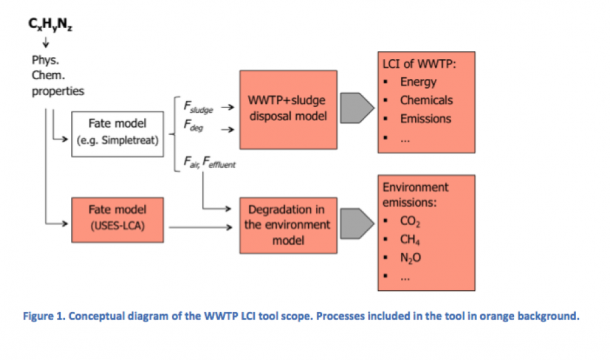A new wastewater initiative
July 28, 2015 by Ivan Muñoz
Chemicals are ubiquitous. They are needed, directly or indirectly, for all products and services. In consumer products in particular, very often the fate of chemicals after consumer use is to be sent down the drain to municipal wastewater treatment plants (WWTP).
In these plants typically they are subject to biological treatments leading to their degradation, and to the discharge of the degradation products to the environment. However different chemicals behave differently in WWTPs, depending on their physical- chemical properties and biodegradability. An accurate modelling of the life cycle impacts of chemicals requires taking into account this specific behaviour in a WWTP, namely whether a chemical will be:
- Degraded,
- Volatilized,
- Persistent and just change phase to the sludge,
- Persistent and be discharged to the environment, unchanged,
- A combination of the above.
WWTPs have been extensively assessed by means of LCA. Besides case studies on particular plants, some models are available which allow the practitioner to obtain the inventory for treating a wastewater that has a particular pollution load. The best example of this is the model developed by Gabor Doka for the ecoinvent database, programmed in Excel (Doka 2007). With this tool it is possible to quantify the inputs (chemicals, energy, etc.) and outputs (emissions to air, water, soil) from treating wastewater, including not only the WWTP itself but also sludge treatment through incineration or spreading on farmland.
However, the major drawback of this model, when applied to chemicals, is that it considers the average fate of chemical elements in typical municipal wastewater. Thus this tool cannot be used to accurately reflect the fate of specific chemicals or chemical mixtures in a WWTP.
To alleviate this we have, together with Henkel and Procter & Gamble, started the wastewater LCI initiative with the aim of developing a model to calculate life cycle inventories of chemical substances sent down the drain, taking into account wastewater treatment, sludge disposal, and degradation in the environment (see figure 1). This project is established as a club to which anyone can subscribe. The wastewater life cycle initiative is administrated by 2.-0 LCA consultants. For more information and subscription, please contact 2.-0 LCA consultants: https://lca-net.com/clubs/wastewater/
Doka G (2007), Life Cycle Inventories of Waste Treatment Services. Final report ecoinvent 2000 No. 13, EMPA St. Gallen, Swiss Centre for Life Cycle Inventories, Duebendorf, Switzerland.
